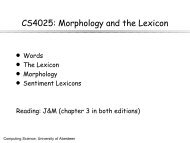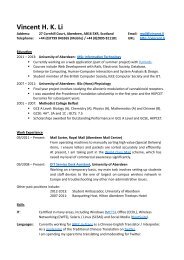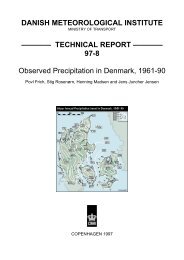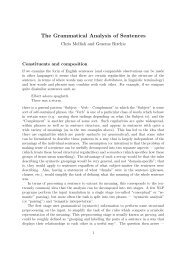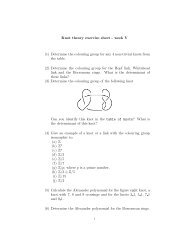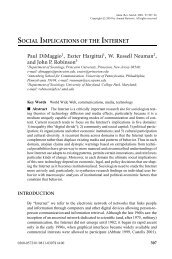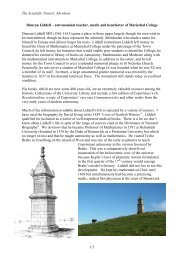Semantic Web-based Source Code Search - Homepages
Semantic Web-based Source Code Search - Homepages
Semantic Web-based Source Code Search - Homepages
Create successful ePaper yourself
Turn your PDF publications into a flip-book with our unique Google optimized e-Paper software.
<strong>Semantic</strong> <strong>Web</strong>-<strong>based</strong> <strong>Source</strong> <strong>Code</strong> <strong>Search</strong><br />
Iman Keivanloo 1 , Laleh Roostapour 1 , Philipp Schugerl 1 , Juergen Rilling 1<br />
1 Department of Computer Science and Software Engineering, Concordia University,<br />
Montreal, QC, Canada<br />
{i_keiv,l_roost, p_schuge, rilling}@cse.concordia.ca<br />
Abstract. The ability to search for source code on the Internet has proven to be<br />
essential for many common software development and maintenance tasks.<br />
However, available code search engines are typically limited to lexical searches<br />
and do not take in consideration the underlying semantics of source code such<br />
as the program structure or language. Especially object-oriented source code,<br />
which includes inheritance and polymorphism, is often not modeled to a level<br />
in which it can be queried sufficiently. In this paper, we present a <strong>Semantic</strong><br />
<strong>Web</strong>-<strong>based</strong> approach to source code search that uses ontologies to model and<br />
connect source code fragments extracted from repositories on the Internet. This<br />
modeling approach allows us to reason and search across project boundaries<br />
while dealing with incomplete knowledge and ambiguities. In comparison with<br />
other search tools, we incrementally build our knowledge base without the need<br />
to re-visit fragments or compile the source code. Our search engine is scalable<br />
and allows us to process and query a large code base collected from opensource<br />
projects.<br />
Keywords: <strong>Semantic</strong> <strong>Web</strong>; source code; search engine; ontology<br />
1 Introduction<br />
Today’s software development tools perform reasonably well in providing search<br />
facilities within the boundaries of the compilable components of a software system<br />
under development. However, the need for similar powerful search capabilities on<br />
source code available outside this scope, across project boundaries and the Internet,<br />
has so far often been neglected. While there exists some work on source code search<br />
in general [1,2], only limited research has focused on source code search on the<br />
Internet [3,4,5]. Internet-scale source code search differs from traditional search<br />
methods, due to (1) the heterogeneity of its resources from where information has to<br />
be extracted, (2) the problem of scalability due to the large amount of information that<br />
has to be searched and (3) the incomplete data and implicit and explicit dependencies<br />
among code segments [6].<br />
The <strong>Semantic</strong> <strong>Web</strong> has not yet played the key role in improving <strong>Web</strong> search due to<br />
the unavailability of information resources that support easy automated population of
the necessary knowledge bases. Nevertheless, its core technologies pave the way for a<br />
better searchable and semantic rich Internet in the near future. In contrast to arbitrary<br />
content available in natural language, the automatic population of source code to<br />
<strong>Semantic</strong> <strong>Web</strong> knowledge bases is relatively straight-forward since data is already<br />
represented in a structured way [7]. Recent work has shown that existing <strong>Semantic</strong><br />
<strong>Web</strong> approaches can provide online search services for large amounts of data such as<br />
DBpedia which covers around 500 million triples [8].<br />
In our research, we introduce a new approach in which we model source code<br />
using Description Logic (DL) and use <strong>Semantic</strong> <strong>Web</strong> reasoners to complete or deal<br />
with missing knowledge. Furthermore, we discuss how our search engine can handle<br />
large amounts of data typically found in the Internet. We first identify usage scenarios<br />
for source code search and classify the type of queries such scenarios should support.<br />
We then show how we can address each type of query and how our results differ from<br />
traditional code search engines. <strong>Semantic</strong> <strong>Web</strong> reasoners allow for complex queries to<br />
support source code searches involving transitive closure, unqualified name resolution<br />
and dynamic code analysis. We have implemented a proof of concept implementation<br />
that has been integrated within our existing SE-Advisor project [9].<br />
The <strong>Semantic</strong> <strong>Web</strong> provides the enabling technologies that allow us to analyze and<br />
search for certain semantics in source code and provides the means to deal with<br />
transitive closure and incremental data analysis. Since repositories contain both the<br />
knowledge and data required for automated reasoning, new information can be<br />
incrementally added. Furthermore, the Open World Assumption (OWA) has various<br />
applications in this global search domain such as “Identify all classes that are not a<br />
subtype of a specified interface”. Considering possibly incomplete data, the OWA<br />
must hold to avoid any invalid result for such queries.<br />
Our research is significant for several reasons: (1) We model source code and<br />
programming language specifics in OWL with the specific usage scenario of source<br />
code search and show how this impacts our ontology design. (2) We provide a<br />
scalable and incremental approach to build a source code knowledge base that is able<br />
to deal with incomplete information and can be used by web crawlers. (3) We use<br />
<strong>Semantic</strong> <strong>Web</strong> reasoners to complete missing and consolidate ambiguous information.<br />
(4) We illustrate how a semantic source code search engine can benefit software<br />
developers/maintainers during typical maintenance tasks.<br />
The remainder of this paper is organized as follows. Section 2 defines what is<br />
covered by our <strong>Semantic</strong> <strong>Web</strong>-<strong>based</strong> source code search and introduces several usage<br />
scenarios and problems with traditional search engines. In Section 3, we first describe<br />
the architecture of our search engine and then pick up the previously described usage<br />
scenarios to discuss our ontology design in detail. Related work is discussed in<br />
Section 4 and Section 5 concludes with a summary of our approach and discusses<br />
future work.<br />
2 <strong>Semantic</strong> <strong>Web</strong>-<strong>based</strong> <strong>Source</strong> <strong>Code</strong> <strong>Search</strong><br />
Different definitions exist as what constitutes a large scale source code search. In [7]<br />
the term Internet-scale <strong>Code</strong> <strong>Search</strong> was introduced and defined as the process of
searching over a large number of open source projects and other complementary<br />
information resources such as, web pages and wiki pages that include source code. In<br />
[10] the term Next-Generation <strong>Code</strong> <strong>Search</strong> was presented to describe a source code<br />
search that considers structural code information and provides services to support<br />
other software engineering activities. In the context of our research we combine and<br />
extend the functionalities covered by these existing source code search definitions by<br />
three major factors: (1) The ability to search over a large amount of source code such<br />
as found on the Internet, (2) fine-grained structural search capabilities and dynamic<br />
code analysis and (3) the support for incomplete source code fragments. <strong>Code</strong><br />
fragments, in this work, are defined as physically separated pieces of code (e.g. a<br />
class file or a few lines of code within a web page) which are syntactically correct and<br />
have a logical dependency to other code fragments.<br />
In this paper, we are interested in improving both the completeness and precision<br />
of search results compared to existing source code engines available on the <strong>Web</strong>. It<br />
has to be pointed out, that dealing with source code fragments is inherently more<br />
difficult than source code search within a project that can be build (has all source code<br />
available e.g., within Eclipse). Dependencies among code fragments (e.g. library<br />
dependency represented by import statements in Java) need to be resolved without<br />
holding any assumption about the order and the availability of other fragments and<br />
without compromising the scalability of the engine. This is one of the main challenges<br />
of source code search on the Internet and a motivating start point for our research. In<br />
what follows we will discuss the type of source code search scenarios that should be<br />
supported.<br />
2.1 Usage Scenarios<br />
<strong>Source</strong> code search in the Internet is motivated by both, the possibility to re-use high<br />
quality code fragments from open source projects as well as gaining a general<br />
understanding of a piece of code (code comprehension). A typical search scenario is<br />
the identification of code fragments that describe how a class is instantiated. While<br />
this might seem trivial, today’s complex software designs and layers of libraries that<br />
build on each other make the search for correct parameters a rather regular activity.<br />
For example, the new object could be instantiated by calling several methods of a<br />
library in a predefined order specified by the design of the target software. To be able<br />
to support a developer in such scenarios the engine must extract different types of<br />
information from source code. This following section discusses these types of<br />
information.<br />
Existing research in the source code search domain [4,7,11] and related research in<br />
regards to maintenance tasks [1,2] was able to identify a limited number of frequently<br />
asked basic core queries. In what follows, we provide a categorization of these core<br />
queries into three categories <strong>based</strong> on their search requirements and various query<br />
examples.<br />
Structural Analysis. Queries that focus on structural aspects of available source code<br />
typically provide information available at the annotated AST (Abstract Syntax Tree)<br />
level. Examples are queries related to method definitions, variables of a specific type
and specific scope or searches to find all packages imported by a particular class.<br />
Even with this category being the simplest form of queries, there are cases in which<br />
many existing publicly available search engines will fail to provide precise results.<br />
import packageA.*;<br />
public class ClassX {<br />
TargetType var;<br />
}<br />
Fig. 1. The visibility and fully qualified type name of the TargetType is determined by the<br />
programming language and underlying semantics. The ontology and reasoner must handle such<br />
ambiguity.<br />
Given the query “Find classes that have a variable of a type packageA.TargetType”<br />
and the code fragments shown in Fig. 1, most source code search engines will fail to<br />
provide results. We chose this rather primitive motivating example to demonstrate the<br />
limitation of search engines that do not analyze the semantics of source code and only<br />
perform a lexical search.<br />
In this particular scenario the search engine has to be aware of programming<br />
language semantics (Java uses package visibility as the default visibility) and must be<br />
able construct the fully qualified type name out of the import statement in the<br />
beginning of the file. Also note how in the example the import packageA.*<br />
statement makes it ambiguous to resolve the type of TargetType as it could be part<br />
of the package packageA or the current package. This is further referred to as the<br />
unqualified name resolution problem.<br />
For a more complex structural analysis it is also required that search engine can<br />
handle transitive closures as part of a search. An example for a transitive search is the<br />
following involving object-oriented inheritance structures. Suppose there are three<br />
classes of A, B and C and an instance x which belongs to C. A is the super-type of B<br />
and B is super-type of C. In this case, if a user searches for those variables that belong<br />
to A, x must be considered as one of the answers. Similar queries could involve class<br />
level information involving all sub-types or super-types of a specific class. During<br />
program comprehension, an interesting application for this static analysis is the ability<br />
to return all package dependencies that a specified class/package depends on (including<br />
imports and imported by dependencies).<br />
Dynamic <strong>Code</strong> Analysis. Much of the encoded dynamics available from source code<br />
fragments are not identifiable by traditional search engines. While a simple textual<br />
search might reveal the usage of a static type, such search engines do not consider the<br />
dynamic type of a variable. For example, if a chained method call<br />
method1().method2() is used, the return type of method1 is never mentioned<br />
explicitly such as the given example in Fig. 2. In object oriented programming<br />
languages this problem becomes even more complex due to polymorphism. In order<br />
for a search engine to be able to answer this type of questions, it is necessary to<br />
analyze the program flow prior to returning the results. Dynamic code analysis<br />
represents a key challenge by requiring e.g. method interfaces to be matched between<br />
method callers and callees. Queries like “Identify all uses of a method” are a common<br />
[1] and can only be answered correctly by considering the program flow.
ClassX var;<br />
var = new ClassY();<br />
var.method1().method2();<br />
Fig. 2. Example source code which benefits from a dynamic code analysis. An instance of var<br />
is defined as a type ClassX and the method method1 is called on the variable, its dynamic<br />
type being ClassY. Also note how the class of method2 cannot be determined with a simple<br />
regular expression (lexical search).<br />
A semantic source code search engine must support some form of transitive<br />
resolving mechanism to provide more complete and precise results for method<br />
invocations. Obtaining complete results from a structural analysis is a non-trivial and<br />
often impossible task [12] but we do expect that the applied techniques should provide<br />
improved precision compared to traditional search engines.<br />
Metadata Analysis. Common to all previous query categories is that they operate on<br />
source code as the sole information source. For metadata queries additional<br />
information that is not directly available in the source code, such as project<br />
information or related artifacts, is considered. Such queries will be typically combined<br />
with other query categories to restrict their result sets. A typical query could be<br />
“Identify all source code belonging to a certain project” or “List source code<br />
available under the GPL license”.<br />
3 <strong>Semantic</strong> <strong>Web</strong>-<strong>based</strong> <strong>Search</strong> Infrastructure<br />
Our <strong>Semantic</strong> <strong>Web</strong> application is mostly using standardized components, such as the<br />
persistent storage, reasoners and the Sparql-Endpoint. The main ideas and concepts<br />
introduced in this paper are realized in the ontologizer component. Fig. 3 shows a<br />
high-level overview of all components.<br />
We distinguish two forms of reasoners due to the type of inference required: DL<br />
and light-weight reasoners. We consider those reasoners that do not fully support<br />
OWL-Lite (the simplest subset of OWL 1) as light-weight reasoners as discussed in<br />
[13]. A DL reasoner is responsible for complex analysis such as required by our<br />
dynamic code analysis. Light-weight reasoners cover transitive closure and<br />
classification tasks required by the structural or metadata analysis. While light weight<br />
reasoners typically are attached to the RDF repository, it is reasonable to detach a DL<br />
reasoner and only apply it to filtered data from the repository in order to cope with<br />
scalability issues. Based on the input query, the engine must select the appropriate<br />
reasoner.
Fig. 3. The high-level schema of our <strong>Semantic</strong> <strong>Web</strong>-<strong>based</strong> source code search engine. The<br />
described core infrastructure does not yet provide additional processing such as result ranking<br />
or data mining.<br />
The architecture provides two approaches for executing source code queries. The<br />
GUI is used to execute Sparql queries directly on the repository from an Eclipse plugin<br />
while the web service provides programmatic access to the data. A source code<br />
slicer is required for presentation of the cached results and to select those lines of<br />
code that are related to the answer statement (similar to the text preview shown in<br />
Google searches). Other major components that are part of our infrastructure are: an<br />
AST builder, a <strong>Web</strong> crawler and the source code repository itself. The crawler<br />
connects to source code resources on the <strong>Web</strong> and populates the source code<br />
repository. This repository contains source code in its original format. The AST<br />
builder analyzes the fragments available in the source code repository and creates a<br />
separate AST for each source code fragment. This approach is <strong>based</strong> on the noordering<br />
assumption discussed earlier in this paper. To avoid unnecessary resource<br />
consumption in terms of processing and memory, we created an optimized ontology<br />
for the architecture. The core ontology pre-ont, is the basis for the run-time populated<br />
ontology post-ont. The output ontologies will be saved into RDF repository<br />
component.<br />
3.1 Ontology Design Discussion<br />
The <strong>Semantic</strong> <strong>Web</strong> provides several languages for knowledge representation and<br />
sharing. During the language selection in the ontology design phase, the designer<br />
must consider both functional and nonfunctional requirements, a tradeoff between<br />
expressivity and computational performance. Moreover, each language provides a set<br />
of properties with possible side effects of which the designer must be aware to avoid
any unexpected result from both a logical and computational point of view [14]. In the<br />
following, properties from <strong>Semantic</strong> <strong>Web</strong> languages for our pre-ont and post-ont<br />
ontologies are discussed in detail.<br />
The metadata analysis of source code requires rdfs:Class, rdfs:subClassOf and<br />
rdf:type [15,16] properties to build e.g. a taxonomy of projects. Therefore RDFS is<br />
sufficient to answer queries related to this kind of analysis. Considering objectoriented<br />
languages, the two most coarse-grained properties are package and class<br />
definitions for which a hierarchy needs to be modeled. Moreover, each class has some<br />
property and method definitions including their signatures and local variables for<br />
which both Is-A and Part-Of relationships need to be modeled. Modeling objectoriented<br />
source code is a kind of metamodeling, as defined in [17], which is not easy<br />
to achieve considering both expressivity and performance and may lead to<br />
undecidability [1,17].<br />
There exist some specific types of OWL that deal with metamodeling problem<br />
such as OWL FA [18]. However in this paper we focus on the challenges of scalable<br />
metamodeling of source code (specifically object-oriented source code) from an<br />
implementation point of view. Our goal is to satisfy the requirements of such search<br />
engines by a limited subset of <strong>Semantic</strong> <strong>Web</strong> languages. In the following three<br />
possible metamodeling approaches for object oriented programming languages using<br />
current <strong>Semantic</strong> <strong>Web</strong> languages are discussed:<br />
• Tbox-<strong>based</strong> metamodeling (i.e. mainly concepts, roles and possible restrictions)<br />
• Mixed metamodeling (Tbox and Abox)<br />
• Abox-<strong>based</strong> metamodeling (i.e. mainly individuals, roles and restrictions)<br />
The underlying rationale here is to avoid the possible overlap between concept and<br />
individual which may lead to OWL Full [13]. The regular way to model a Is-A<br />
relationship in the <strong>Semantic</strong> <strong>Web</strong> is the subtype property (rdfs:subClassOf). However,<br />
writing logical constructions for reasoning on Part-Of relation is more challenging to<br />
model since either an existential quantification or the owl:hasValue property may be<br />
used in addition to available roles. Contrary to the two first solutions, the last approach<br />
does not use concept hierarchies for Is-A modeling and simply uses roles to model all<br />
kind of relations.<br />
Since <strong>Semantic</strong> <strong>Web</strong> reasoners are mostly optimized for Tbox reasoning due to<br />
their historical background, the two first approaches could be considered more<br />
reasonable than the last one. However, Tbox metamodeling has deficiencies in the<br />
source code search domain if we want to avoid the undecidability problem. Some of<br />
the solutions lead to models which are more complicated than our requirements (for<br />
example modeling a class declaration and implementation using two concept and<br />
individual entities respectively). While complex models may support more details<br />
about the domain, they also require more space to store and time to process affecting<br />
the scalability of our approach. Furthermore, the core model must be able to support<br />
requirements defined by other groups of queries or client-side applications. To avoid<br />
any unnecessary modeling complexity, one solution is to use Tbox for both class<br />
declaration and implementation level modeling but there are some applications for<br />
source code search and specifically for software maintenance which cannot be<br />
satisfied. For example, it is not possible to express some restrictions on the super-types<br />
of an entity using Description Logic. An alternative solution is the Abox-<strong>based</strong><br />
approach. It satisfies the previous requirements and requires fewer triples to be
modeled by omitting unnecessary details (i.e. differentiation between the type<br />
declaration and implementation). The following language properties are required for<br />
Abox-<strong>based</strong> metamodeling in this domain:<br />
• Concept: For domain modeling, e.g., package, class and method concepts.<br />
• Individual: For entities such as a specific Java class, a local variable, etc.<br />
• Role (owl:ObjectProperty): For any kind of relationship (incl. Part-Of and Is-A)<br />
So far we discussed how metamodeling could be implemented for the structural<br />
analysis but failed to discuss the unqualified name resolution mentioned earlier. Two<br />
solutions have been designed in this paper to address the resolution problem. The first<br />
approach is a verbose modeling approach which is called loose unqualified name<br />
resolution. The other approach uses a DL reasoner to resolve the names accurately<br />
and is further referred to as full unqualified name resolution. It is important to<br />
mention that there is no contradiction between them and that they are actually<br />
complementary. Loose unqualified name resolution can be applied by default and<br />
then, depending on the available processing resources, a DL reasoner may be used to<br />
make the result of the first approach more accurate. The reason for this separation is<br />
the computational overhead associated with full unqualified name resolution. Loose<br />
unqualified name resolution uses similar properties as in the metamodeling section<br />
while full unqualified name resolution uses rdfs:subClassOf, owl:hasValue and<br />
owl:equivalentClass properties. The rationale of these two approaches is described in<br />
next section as part of our description of the ontology.<br />
Although OWL offers many interesting properties that can be used here such as<br />
complement, union, disjoint, inverse property and universal quantification, we have<br />
decided not to include them in our core ontology because of their computational<br />
overhead. This decision may restrict the expressivity of the ontology but has been<br />
taken out of our experience with very large ontologies which is supported by the<br />
discussion in [19]. The core ontology is modeled only <strong>based</strong> on the specified<br />
properties for each analysis. Sophisticated related tasks could be implemented at the<br />
client-side using any other properties from <strong>Semantic</strong> <strong>Web</strong> languages. Union and<br />
inverse properties are valuable especially for the software comprehension and<br />
maintenance domain [1]. To address them in the core level, query language facilities<br />
can be used. In addition, the inverse property can be represented explicitly within the<br />
populated ontology. Our resulting ontology language is a subset of OWL-Lite except<br />
for dynamic code analysis and the optional unqualified name resolution approach that<br />
is reasoner-<strong>based</strong> since these two sections require the owl:hasValue property that<br />
leads to OWL-DL. Considering OWL 2.0, the OWL 2 EL [19] covers all the required<br />
properties which also supports the design decisions that have been made regarding the<br />
exclusion of disjunction, inverse role and negation for computational performance<br />
reasons.<br />
3.2 <strong>Source</strong> <strong>Code</strong> Ontology<br />
Our ontology includes some very high-level concepts <strong>based</strong> on the two core source<br />
code ontologies found in [9,20]. Based on the high-level concepts, other details have<br />
been added to support previously discussed usage scenarios. The basic ontology with
populated samples is available online 1 . The populated samples are <strong>based</strong> on the given<br />
techniques discussed in this section. In the following, those parts that are more<br />
interesting and related to this paper are discussed.<br />
Type hierarchy. We use individuals to represent types (i.e. class and interfaces in<br />
object-oriented language paradigms) and their implementation details, according to<br />
the A-Box metamodeling approach discussed in the previous section. To simulate the<br />
transitive closure that might exist between these types, the OWL transitivity property<br />
is applied on the relevant roles. As a result, the object-oriented classes defined in the<br />
source code are represented as individuals of Class/Interface concept. Variables are<br />
also defined as individuals belonging to the Variable concept. In order to be able to<br />
represent inheritance hierarchies and the relationships between the instances and the<br />
classes, we use a single transitive role which is hasType. Fig. 4 shows the very highlevel<br />
overview of the ontology focusing on metadata queries.<br />
Fig. 4. High-level concepts of our ontology related to the metadata section that is mostly being<br />
used to restrict query results.<br />
Package hierarchy and dependencies. Packages or namespaces are a way to<br />
categorize source code in programming languages. There are two kinds of<br />
relationship that can be distinguished: The ownership relation among<br />
classes/packages themselves and the dependency relationships between classes and<br />
packages. The ownership relationship is represented using belongsTo and<br />
hasSubPackage roles. These roles allow a user to search for packages and review the<br />
classes belonging to a current package or all its sub packages (by using transitive<br />
closure). The dependency relationship is modeled through the imports role and<br />
establishes the relationship to both classes and packages. Considering software<br />
maintenance requirements, uses is one role representing a typical dependency among<br />
software entities. A typical application example in the software maintenance domain<br />
would be a <strong>Semantic</strong> <strong>Web</strong> application that requires a set of related information with<br />
1 http://aseg.cs.concordia.ca/ontology/#sourcecode
espect to a target entity [2]. Additional support for other maintenance applications is<br />
provided by another version of the uses role in the ontology which has a transitivity<br />
property.<br />
Class details. Fig. 5 shows the corresponding concepts and roles required for the<br />
source code implementation representation. The ontologizer creates the post-ont<br />
ontology by adding new individuals <strong>based</strong> on the predefined concepts in pre-ont for<br />
each code fragment (e.g. a Java class). Following this approach, the roles in the<br />
ontology are used to represent the implementation details for the available source<br />
code. The method signatures are modeled using a series of roles like hasFirstParam<br />
and hasSecondParam. Although there are other approaches to model the input<br />
parameters of a method using <strong>Semantic</strong> <strong>Web</strong> languages, the proposed solution is<br />
sufficient for our usage scenarios.<br />
Fig. 5. Concepts and roles that are part of the discussed ontology design. There exist some less<br />
important detailed entities in the ontology such as extends, implements and hasDefiendType<br />
which are not shown in the overview.<br />
Methodcalls and return statements. At the source code level, method call<br />
statements are of significance. We represent method calls using individuals of the<br />
MethodCall concept defined in the ontology. Each class or method is an owner of<br />
such individuals using the hasMethodCall role. However, each method call statement<br />
has two important pieces of information associated, the method and the caller. These<br />
two are required in order to perform a dynamic code analysis, especially for objectoriented<br />
code since the caller type determines the actual callee (i.e. method<br />
implementation). According to the challenges mentioned in the previous sections, the<br />
ontologizer cannot specify the receiver at post-ont creation time in most cases.<br />
Consequently, another component is needed to resolve this problem. The ontologizer<br />
only creates an individual of the MethodCall concept and models the caller and callee<br />
information using hasCaller and callsMethod roles. If a method has input parameters,<br />
these parameters must be modeled using the available roles to support method<br />
overloading.<br />
The caller individual can be a class, a variable or even another method call with a<br />
type that is being determined by the return statement of the method being called. The<br />
ReturnStm concept is a key concept for solving many of our modeling challenges. The
ontologizer is responsible to create a new sub concept from ReturnStm for each return<br />
statement in the code. Note that this is the first step where the ontologizer must create<br />
concepts instead of individuals. Each new sub concept contains two pieces of<br />
information which are an OWL equivalent restriction and an OWL subclass<br />
restriction. The equivalent restriction is filled using the pattern (presented using<br />
Protégé [21] OWL terminology): hasCaller some (hasType value [Owner<br />
class of the method]) and callMethod value [Method<br />
specification]. In addition, the subclass restriction will be populated using:<br />
hasType value [Corresponding individual for the right hand<br />
side of the return statement]. Fig. 6 presents a sample for this pattern. It<br />
states that whoever calls the method and hasType of the specified class, must have the<br />
type of the right hand side of the return statement. It is the reasoner’s responsibility to<br />
infer the method call types using the added return statements.<br />
The key advantage of this solution, compared to traditional ones used in objectoriented<br />
source code analysis, is that source code can be analyzed in no order and in<br />
one-pass as it is required by a search engine crawler that visits one web-site at a time<br />
without prior knowledge of the web structure. This also allows the parallelization of<br />
crawling and increases the scalability of our infrastructure.<br />
<br />
<br />
<br />
<br />
<br />
<br />
<br />
Fig. 6. A sample populated partial ontology for a return statement in Java code.<br />
Unqualified name resolution. Based on our previous discussion, one of the main<br />
issues in source code processing is the need to handle unqualified names that may<br />
occur. A user must be able to search by the qualified name of a class instead of its<br />
unqualified name to increase the result accuracy. Considering that we have to deal<br />
with typically incomplete data, this requirement, while a relatively trivial problem for<br />
local source code searches, is inherently more challenging for Internet-<strong>based</strong> source<br />
code search approaches. As mentioned in the previous section, we introduce two<br />
approaches to address this problem: loose unqualified name resolution and full<br />
unqualified name resolution (which requires a DL reasoner).<br />
Loose unqualified name resolution tends to predict all the possible qualified names<br />
for each unqualified name instance <strong>based</strong> on local information available for each<br />
segment. Given this approach, for each potential result, one individual of type<br />
TempResolvedType is instantiated. While it might seem that by using this approach<br />
we are adding invalid information to our repository, this is not the case, since we<br />
separate this temporarily information of resolved types from the actual Class or<br />
Interface information. This allows us, even without using the second approach, which<br />
is complementary to this one, to answer backward queries correctly. For example a<br />
query that asks for “Variables that belong to class java.io.File”. Since such queries
use a valid qualified name as the input they will never be affected by some of the<br />
potentially invalid qualified names inserted temporarily into the repository.<br />
Full unqualified name resolution is designed using inter-segment inferences. In<br />
this reasoner-<strong>based</strong> approach, a sub concept of UnqualifiedResolution is created for<br />
each qualified name. Then, using OWL equivalent and subclass restrictions, it is<br />
stated that there is an individual belonging to a TempResolvedType concept. If it has<br />
the specified qualified name then it actually belongs to Class/Interface concept. In this<br />
way once a type resolved successfully then all the loose resolutions will be resolved<br />
using the reasoner. The interesting aspect of this solution is its capability of resolving<br />
names even if the actual type implementation has never been analyzed prior by the<br />
ontologizer as long as it has occurred at least once as a qualified name through the<br />
whole repository.<br />
3.3 Implementation<br />
We developed a Java application as a proof of concept <strong>based</strong> on the discussed<br />
architecture and ontology. Since one of the main applications is in software<br />
maintenance and comprehension, it is also integrated with our current SE-Advisor, an<br />
ongoing project on semantic modeling of software artifacts [9], process modeling, and<br />
semantic analysis [22] to support the evolution and maintenance of software systems.<br />
A snapshot of our current search plug-in is shown in Fig. 7. The SE-Advisor provides<br />
a user not only access to source code but also to the related information extracted<br />
from other resources such as bug trackers.<br />
Most of our tool chain is adopted from available software components. Javaparser<br />
[23] is used for the AST construction and ontology manipulation tasks respectively.<br />
RacerPro [24], is used to run Sparql queries against the populated post-ont ontology.<br />
While advanced users may run their customized query directly using the provided<br />
web services or download the knowledge base for further processing, a set of predefined<br />
core functionalities are provided by our GUI. Using the GUI there is no need<br />
to write any kind of query which is helpful for those users without prior knowledge of<br />
ontology query languages.<br />
While we previously discussed all the pre-ont and post-ont details, we have not yet<br />
addressed the way identifiers (e.g. URI) must be created during the post-ont<br />
population. There are three kinds of identifiers: Some must be created randomly since<br />
they have to be unique (considering the complete knowledge base) such as return<br />
statements. Others, such as types, must have a qualified name inside the post-ont<br />
ontology. Methods, on the other hand, are independent from the owner classes<br />
according to the ontology design. This approach ensures that entities will have<br />
consistent identifiers even when they are produced completely separately. This also<br />
enables the parallel processing of web content through multiple crawlers. Although an<br />
identical behaviour could be implemented using owl:sameAs in a post-production and<br />
integration step, we decided not to use it because of its memory and processing<br />
overhead.
Fig. 7. Eclipse plug-in integration that enables code search directly out of the IDE. Using this<br />
form of global source code search, a user may search for e.g., all usages of a certain type, not<br />
only locally but globally in all available source code on the Internet. Resources that are within<br />
the currently opened Eclipse projects are automatically linked to the results so that doubleclicking<br />
a file opens the local copy. Other results (marked X) are opened in the internal Eclipse<br />
web-browser from the source code repository.<br />
Our current implementation does not support queries related to versioning. That is,<br />
if there are two versions of a specific source code fragment, the engine considers them<br />
as separated entities in the repository and also within the ontology. From an<br />
ontological point of view, basic versioning knowledge could be modeled easily but<br />
the major roadblock is the required input data. Extracting versioning information from<br />
source code found on the Internet is a challenging and ongoing research topic in<br />
source code analysis which is out of scope of this paper. However, if such information<br />
is extracted (or is added manually) the underlying architecture of our search engine<br />
can support versioning queries using the chosen expressivity.<br />
4 Related Work<br />
Description Logics and the <strong>Semantic</strong> <strong>Web</strong> have been used to represent a software<br />
project formally. Although the infrastructure of development environments is not<br />
<strong>based</strong> on DL, the conversion mostly has been done for software maintenance<br />
purposes. One of the early applications of DL surfaced in the software engineering<br />
domain in program comprehension and maintenance. This kind of formalism is used<br />
for two main purposes which are domain knowledge maintenance and source code<br />
comprehension. LaSSIE [25] is one the successful applications of the former. By<br />
modeling the domain knowledge the maintainer was presented with the ability to<br />
locate related information about a specific concept. As an example for the latter, [2]<br />
used DL for source code modeling to support program comprehension considering<br />
specifically the ability of backward trace (i.e. inverse roles), path tracing (i.e. having<br />
all related information in one place) and classification. Recently, those three<br />
applications also have been explored using <strong>Semantic</strong> <strong>Web</strong> languages. In [26],
ontologies are used to represent source code formally and to find security related<br />
vulnerabilities. It has been implemented by defining those patterns formally and using<br />
a reasoner for classification. Another sample of <strong>Semantic</strong> <strong>Web</strong> applications in<br />
Software Engineering is presented in [9] and mainly focuses on representing the links<br />
required for software maintenance tasks. However, all of these works mainly focus on<br />
establishing links between source code and other artifacts or represent localized<br />
models that only focus on project specific artifact searches.<br />
Previous work on Internet-scale code search has focused on different search<br />
aspects. Reiss [27] emphasized on a source code search approach that returns a<br />
complete working code segment rather than a set of (often partial) code fragments.<br />
Following this approach, the S6 project [27] requires users to specify test cases and a<br />
list of keywords, which are used to retrieve the closest match to a given piece of code.<br />
As mentioned in [27], a general challenge is to derive strategies on how to avoid an<br />
exponential number of results. Within our work we address this challenge by applying<br />
our two step processing strategy. Similar to the S6, the PARSE<strong>Web</strong> project [28] tries<br />
to find examples for complex object creation by modeling them as a method<br />
invocation sequence problem. PARSE<strong>Web</strong>’s main contribution is that it also supports<br />
some source code analysis during the search by resolving the receiver of method calls.<br />
However, since PARSE<strong>Web</strong> is using an external, traditional code search engine it has<br />
not always access to all source code segments and their dependencies and therefore<br />
will not always be able to retrieve correct results.<br />
Assieme [4] is another source code search project which has two interesting<br />
contributions: (1) The ability to find different kinds of resources related to a given<br />
query and (2) being able to resolve possible implicit references. The intention to<br />
include implicit reference resolution as part of the query engine is similar to our<br />
unqualified name resolution. However, the Assieme project uses a complier <strong>based</strong><br />
approach which has two major drawbacks compared to the work introduced in this<br />
paper. Firstly, it requires that each source code has to be compilable which makes it<br />
not suitable in cases when only partial or incomplete code is available. Secondly, the<br />
compilation itself results in an additional cost and performance overhead.<br />
Other source code engines use repositories <strong>based</strong> on relational models to store and<br />
query information. <strong>Source</strong>rer is a relational model <strong>based</strong> repository [10] and search<br />
engine [3] that supports fine-grained structural queries using textual and structural<br />
source code information. Strathcona [5] is a local search engine that supports searches<br />
for code samples. During the search, it relies on structural data stored in a relational<br />
database. The interesting feature of Strathcona is its ability to restrict a method call<br />
query by the receiver type. However, in its current implementation it does not support<br />
hierarchical transitivity.<br />
In addition, there are some other publicly available code search engines on the<br />
<strong>Web</strong> such as Google <strong>Code</strong> <strong>Search</strong> [29], Koders [30], Codase [31], Krugle [32] and<br />
JExample [33]. While these engines cover different open source project and source<br />
codes, they do not provide results for most of the usage scenarios listed in this paper.<br />
A main reason for this deficiency is that they do not apply enough syntax and<br />
semantic-<strong>based</strong> code analysis.<br />
At last, there has been a significant body of work on local search techniques. While<br />
they are focusing on project specific queries, our objectives are completely different
in respect to openness where queries can be geared towards a non-complete search<br />
space across project and even organizational boundaries.<br />
5 Conclusion and Future Work<br />
In this paper, a novel <strong>Semantic</strong>-<strong>Web</strong> enabled source code search is introduced. Our<br />
approach does not only scale in regards to the large amount of source code available<br />
on the Internet but is also optimized to work with web crawlers to incrementally build<br />
a semantic knowledge base. Our approach is scalable as we support one-pass parsing<br />
and do not make assumptions on the order of fragments analyzed. This makes our<br />
<strong>Semantic</strong> <strong>Web</strong> <strong>based</strong> approach unique among other currently adopted approaches for<br />
Internet scale source code search research. We have pointed out various usage<br />
scenarios of source code search in which traditional search engines fail to provide<br />
(complete) results and show how we out-perform them by incorporating source code<br />
semantics into the knowledge base. We have discussed our ontology design in regards<br />
to its strengths and weaknesses and pointed out common pitfalls in designing source<br />
code ontologies in general, and our highly optimized ontology for source code search<br />
in particular. Furthermore, we have analyzed various source code metamodeling<br />
approaches under the aspect of source code search to make our approach scalable.<br />
As part of our future work, we plan to add the versioning information extracted<br />
from metadata to the repository and deal with contradictory information (e.g. through<br />
levels of trust). In addition, more detailed source code query capabilities will be added<br />
to our Eclipse plug-in. We also plan to make our tool available to the community in<br />
form of an open source source code search engine and are currently working on the<br />
web interface for this project.<br />
References<br />
1. Erdos, K., Sneed, H.M.: Partial comprehension of complex programs (enough to perform<br />
maintenance). In: 6th International Workshop on Program Comprehension (1998)<br />
2. Welty, C.: Augmenting abstract syntax trees for program understanding. In: 12th IEEE<br />
International Conference Automated Software Engineering (1997)<br />
3. Bajracharya, S., Ngo, T., Linstead, E., Dou, Y., Rigor, P., Baldi, P., Lopes, C.: <strong>Source</strong>rer:<br />
a search engine for open source code supporting structure-<strong>based</strong> search. In: 21h ACM<br />
SIGPLAN Conference on Object-oriented Programming, Systems, Languages, and<br />
Applications (2006)<br />
4. Hoffmann, R., Fogarty, J.: Assieme: finding and leveraging implicit references in a web<br />
search interface for programmers. In: 20th annual ACM Symposium on User Interface<br />
Software and Technology (2007)<br />
5. Holmes, R., Murphy, G.C.: Using structural context to recommend source code examples.<br />
In: 5th International Conference on Software Engineering (2005)<br />
6. Grove, D., DeFouw, G., Dean, J., Chambers, C.: Call graph construction in object-oriented<br />
languages. In: 12th ACM SIGPLAN conference on Object-oriented programming,<br />
systems, languages, and applications (1997)<br />
7. Gallardo-Valencia, R.E., Sim S.E.: Internet-scale code search. In: 1st ICSE Workshop on<br />
<strong>Search</strong>-Driven Development-Users, Infrastructure, Tools and Evaluation (2009)
8. Auer, S., Lehmann, J.: What have Innsbruck and Leipzig in common? Extracting<br />
<strong>Semantic</strong>s from Wiki Content. In: European <strong>Semantic</strong> <strong>Web</strong> Conference (2007)<br />
9. Rilling, J., Witte, R., Schuegerl, P., Charland, P.: Beyond Information Silos - an<br />
Omnipresent Approach To Software Evolution. J. <strong>Semantic</strong> Computing. 2, 431--468<br />
(2008)<br />
10. Bajracharya, S., Ossher, J.: <strong>Source</strong>rer: An internet-scale software repository. In: 1st ICSE<br />
Workshop on <strong>Search</strong>-Driven Development-Users, Infrastructure, Tools and Evaluation<br />
(2009)<br />
11. Reiss, S.P.: Specifying what to search for. In: In: 1st ICSE Workshop on <strong>Search</strong>-Driven<br />
Development-Users, Infrastructure, Tools and Evaluation (2009)<br />
12. Binkley, D.: <strong>Source</strong> <strong>Code</strong> Analysis: A Road Map. In: 7th Future of Software Engineering<br />
(2007)<br />
13. Guo, Y., Pan, Z., Heflin, J.: LUBM: A benchmark for OWL knowledge base systems. J.<br />
<strong>Web</strong> <strong>Semantic</strong>s: Science, Services and Agents on the World Wide <strong>Web</strong>. 3, 15--182 (2005)<br />
14. Graua, B.C., Horrocksa, I., Motika, B., Parsia, B., Patel-Schneiderc, P., Sattlerb, U.: OWL<br />
2: The next step for OWL. J. <strong>Web</strong> <strong>Semantic</strong>s: Science, Services and Agents on the World<br />
Wide <strong>Web</strong>. 6, 309--322 (2008)<br />
15. RDF/XML Syntax Specification, http://www.w3.org/TR/REC-rdf-syntax, last visited<br />
January 2010.<br />
16. RDF Schema, http://www.w3.org/TR/rdf-schema, last visited January 2010.<br />
17. Motik, B.: On the Properties of Metamodeling in OWL. In: Internationa <strong>Semantic</strong> <strong>Web</strong><br />
Conference (2005)<br />
18. Pan, J.Z., Horrocks, I.: OWL FA: a metamodeling extension of OWL D. In: 15th<br />
International Conference on World Wide <strong>Web</strong> (2006)<br />
19. OWL 2 <strong>Web</strong> Ontology Language Profiles, http://www.w3.org/TR/owl2-profiles, last<br />
visited January 2010.<br />
20. Kiefer, C., Bernstein, A., Tappolet, J.: Analyzing Software with iSPARQL. In: 3rd<br />
International Workshop on <strong>Semantic</strong> <strong>Web</strong> Enabled Software Engineering (2007)<br />
21. Protégé Ontology Editor and Knowledge Base Framework, http://protege.stanford.edu,<br />
last visited Januart 2010.<br />
22. Meng, W.J., Rilling, J., Zhang, Y., Witte, R., Charland, P.: An ontological software<br />
comprehension process model. In: 3rd Workshop on Metamodels, Schemas, Grammars,<br />
and Ontologies for Reverse Engeenirng (2006)<br />
23. Javaparser - Java 1.5 Parser with AST generation and visitor support,<br />
http://code.google.com/p/javaparser, last visited January 2010.<br />
24. Haarslev, V., Moller, R.: RACER System Description. In: International Joint Conference<br />
on Automated Reasoning. R. Goré, A. Leitsch, T. Nipkow (eds.). pp. 701--705. Springer-<br />
Verlag, Berlin (2001)<br />
25. Devanbu, P., Brachman, R., Selfridge, P., Ballard, B.: LaSSIE: a knowledge-<strong>based</strong><br />
software information system. In: 12th International Conference on Software Engineering<br />
(1990)<br />
26. Yu, L., Zhou, J., Yi,Y., Li, P., Wang, Q.: Ontology Model-Based Static Analysis on Java<br />
Programs. In: 32nd Annual IEEE International Computer Software and Applications<br />
Conference (2008)<br />
27. Reiss, S.P.: <strong>Semantic</strong>s-<strong>based</strong> code search. In: 31st IEEE International Conference on<br />
Software Engineering (2009)<br />
28. Thummalapenta S., Xie, T.: PARSE<strong>Web</strong>: programmer assistant for reusing open source<br />
code on the web. In: International Conference on Automated Software Engineering (2007)<br />
29. Google <strong>Code</strong> <strong>Search</strong>, http://www.google.com/codesearch, last visited January 2010.<br />
30. Koders, http://www.koders.com, last visited January 2010.<br />
31. Codase, http://www.codase.com, last visited January 2010.<br />
32. Krugle, http://www.krugle.com, last visited January 2010.<br />
33. JExamples, http://www.jexamples.com, last visited January 2010.



